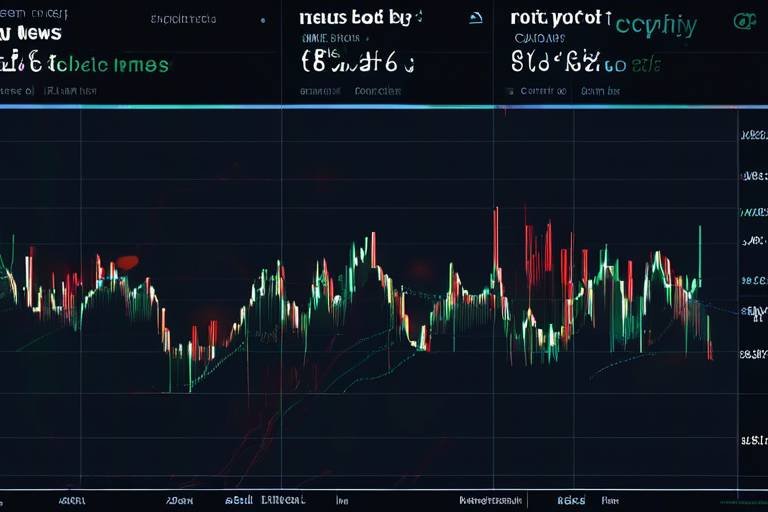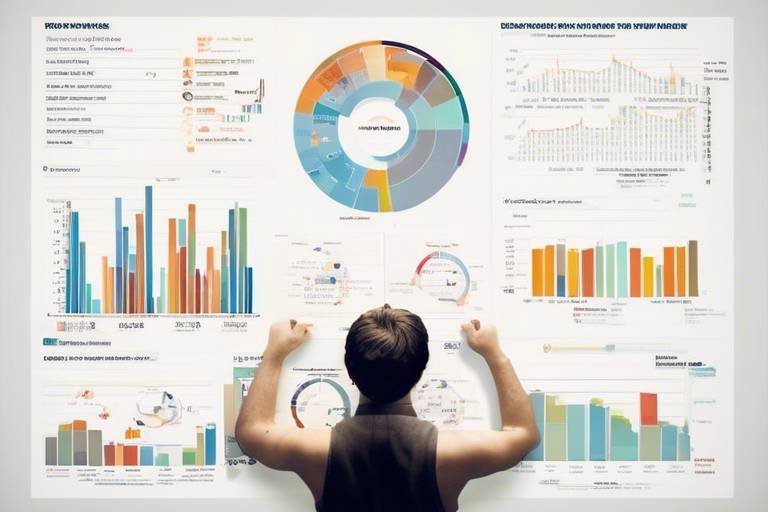Market Analysis - How to Spot Trends Before They Happen
In today's fast-paced business environment, staying ahead of the curve is not just an advantage; it's a necessity. Understanding how to spot market trends before they happen can be the difference between thriving and merely surviving. Imagine being able to predict the next big shift in consumer behavior or the emerging technologies that will reshape your industry. This article will guide you through the essential strategies and techniques for identifying these trends early on, enabling your business to adapt quickly and effectively.
Market trends are essentially the patterns and directions in which consumer preferences and behaviors are moving. They can be influenced by a myriad of factors, including economic conditions, technological advancements, and even cultural shifts. By recognizing these trends early, businesses can make informed decisions that align with the evolving market landscape. But how do you go about identifying these trends? Let’s dive into some key strategies that will empower you to see beyond the horizon.
Before we get into the nitty-gritty of data analysis and consumer behavior, it's crucial to grasp what market trends are and why they matter. Market trends can be defined as the general direction in which a market is moving over time. They are essential indicators for businesses as they help in strategic planning and forecasting future performance. Think of market trends as the weather forecast for your business landscape; knowing whether it’s sunny or stormy can help you decide whether to launch a new product or hold back.
In addition, recognizing market trends can lead to opportunities for growth and innovation. For example, if you notice a rising trend in eco-friendly products, you might consider developing sustainable alternatives in your offerings. Conversely, failing to acknowledge these trends can result in missed opportunities and potential losses. Understanding market trends is not just about reacting; it's about being proactive and positioning yourself to lead.
Now that we have a foundational understanding of market trends, let’s explore some effective data analysis techniques that can help you identify these trends. Data analysis is a powerful tool that allows businesses to sift through vast amounts of information and extract meaningful insights. Techniques such as statistical analysis, data mining, and predictive modeling are invaluable in this regard. They provide a structured approach to interpreting market data, making it easier to spot emerging trends.
Statistical analysis is like putting on a pair of glasses that allow you to see the hidden patterns in your data. By applying mathematical techniques, businesses can uncover underlying trends that may not be immediately apparent. For instance, using methods like regression analysis can help you understand the relationship between different variables, such as price changes and sales volume. This insight can guide your pricing strategies and inventory management.
Regression analysis is particularly powerful for forecasting future trends based on historical data. By analyzing past performance, businesses can create models that predict how changes in one area, like marketing spend, could impact sales. This predictive capability is essential for making data-driven decisions that can significantly enhance your competitive edge.
Another valuable technique is time series analysis, which focuses on data collected over specific intervals. By examining seasonal trends and long-term patterns, businesses can gain insights into cyclical behaviors—like holiday shopping spikes or summer sales dips. This information is crucial for planning marketing campaigns and managing stock levels effectively.
Data mining takes the analysis a step further by discovering patterns within large datasets. It's like searching for gold in a river of information. Businesses can use various tools and techniques to extract valuable insights from consumer data, helping them identify emerging trends before they become mainstream. This proactive approach can lead to innovation and the development of products that meet future consumer demands.
Understanding consumer behavior is another critical piece of the puzzle. By analyzing how consumers interact with products and services, businesses can predict market trends more accurately. This can be achieved through techniques such as market segmentation, which involves dividing your audience into distinct groups based on shared characteristics.
Market segmentation allows businesses to tailor their offerings to meet the specific needs of different consumer groups. For instance, a company targeting millennials might focus on digital marketing strategies, while a brand aimed at older consumers may rely on traditional advertising methods. By understanding these preferences, businesses can align their products and marketing strategies with the trends that matter most to their target audience.
Surveys and consumer feedback are direct lines to understanding what your customers want. They provide real-time insights into consumer attitudes, preferences, and emerging trends. By actively seeking feedback, businesses can adapt their strategies and offerings to stay relevant in a constantly changing market.
Finally, it's essential to recognize external factors—known as industry signals—that can influence market trends. These signals can include economic indicators, technological advancements, and even shifts in cultural attitudes. By staying attuned to these signals, businesses can adjust their strategies proactively.
Economic indicators, such as unemployment rates, consumer confidence, and GDP growth, provide valuable insights into market health. Monitoring these indicators can help businesses anticipate upcoming trends and make informed decisions about investments and resource allocation.
Technological advancements often serve as catalysts for market trends. By keeping an eye on tech developments, businesses can anticipate shifts in consumer behavior and adapt their offerings accordingly. For example, the rise of e-commerce has dramatically changed how consumers shop, and businesses that embraced this trend early on have reaped significant rewards.
Q: How can I start identifying market trends for my business?
A: Begin by analyzing your existing data, utilizing statistical methods, and staying updated on consumer behavior and industry signals.
Q: What tools can help with data analysis?
A: There are numerous tools available, including Google Analytics, Tableau, and various statistical software like R and Python.
Q: How often should I analyze market trends?
A: Regular analysis is key. Depending on your industry, monthly or quarterly reviews can help keep you informed.
Q: Can social media influence market trends?
A: Absolutely! Social media is a powerful tool for gauging consumer sentiment and spotting emerging trends quickly.

Understanding Market Trends
This article explores key strategies for identifying market trends ahead of time, enabling businesses to adapt and thrive in a competitive landscape. Learn how to analyze data, consumer behavior, and industry signals effectively.
Market trends are essential indicators of consumer behavior and economic shifts. They represent the general direction in which a market is moving over a period of time, and understanding these trends is crucial for businesses aiming to stay relevant and competitive. By recognizing market trends, companies can make informed decisions that align with consumer expectations, ultimately leading to increased sales and customer loyalty.
So, what exactly constitutes a market trend? In simplest terms, a market trend is a pattern or movement that affects the overall market dynamics. It can be driven by various factors, including changes in consumer preferences, technological advancements, and economic conditions. For instance, the rise of eco-friendly products is a trend that reflects a growing consumer preference for sustainability. Companies that adapt to such trends often find themselves at a significant advantage.
Understanding market trends is not merely about observing changes; it involves a strategic approach to data analysis and consumer insights. Businesses need to be proactive rather than reactive. This means engaging in regular market research and employing robust analytical techniques to interpret data effectively. By doing so, they can identify trends before they become mainstream, allowing them to capitalize on new opportunities.
Here are some key aspects to consider when analyzing market trends:
- Consumer Behavior: Understanding what drives consumer choices is fundamental. This includes analyzing purchasing patterns, preferences, and feedback.
- Economic Indicators: Monitoring economic conditions such as inflation rates, employment statistics, and consumer spending can provide valuable insights into potential market shifts.
- Technological Changes: Keeping an eye on technological advancements can help businesses anticipate changes in consumer behavior and expectations.
Moreover, it’s essential to differentiate between short-term fads and long-term trends. While fads may provide a quick boost in sales, they are often fleeting and can lead to wasted resources if not managed properly. In contrast, long-term trends can reshape industries and create sustainable growth opportunities.
To put it all together, understanding market trends involves a combination of keen observation, data analysis, and strategic foresight. Businesses that invest time and resources into this process are more likely to navigate the complexities of the market successfully and emerge as leaders in their respective fields.
- What are market trends?
Market trends refer to the general direction in which a market is moving, influenced by various factors such as consumer behavior, economic conditions, and technological advancements.
- Why is it important to understand market trends?
Understanding market trends helps businesses make informed decisions, align their strategies with consumer expectations, and stay competitive in their industry.
- How can businesses identify market trends?
Businesses can identify market trends through data analysis, consumer feedback, market research, and monitoring economic indicators.

Data Analysis Techniques
In today's fast-paced business environment, the ability to spot trends before they become mainstream is invaluable. This is where effective come into play. By employing these techniques, businesses can sift through mountains of data, uncover hidden patterns, and make informed decisions that drive growth and innovation. Let's dive into some of the most impactful methods that can transform raw data into actionable insights.
One of the primary methods used in data analysis is statistical analysis. This approach involves applying mathematical formulas and models to interpret complex datasets. Through statistical analysis, businesses can identify correlations, averages, and distributions that reveal underlying trends in consumer behavior. For instance, a retail company might analyze sales data from the past year to determine which products are gaining popularity and which are not. By understanding these patterns, they can adjust inventory and marketing strategies accordingly.
Within the realm of statistical analysis, there are several powerful techniques that can be employed. Two of the most prominent are regression analysis and time series analysis. These methods help businesses not only understand what has happened in the past but also predict future behaviors based on historical data.
Regression analysis is a statistical method that allows businesses to examine the relationship between variables. For example, a company might use regression analysis to evaluate how changes in pricing affect sales volumes. By creating a regression model, businesses can forecast future trends based on these relationships, leading to more strategic pricing and marketing decisions. This technique can be particularly useful in identifying the factors that drive customer purchases, providing a roadmap for future initiatives.
On the other hand, time series analysis focuses on data points collected over time. This technique is particularly effective in identifying seasonal trends and long-term patterns. For instance, a tourism company might analyze visitor data over several years to determine peak seasons. By understanding these trends, they can allocate resources more efficiently, plan marketing campaigns, and optimize staffing during busy periods. The insights gained from time series analysis can be a game-changer for businesses looking to stay ahead of the curve.
Another essential technique is data mining, which involves the discovery of patterns and relationships within large datasets. This process can reveal insights that are not immediately obvious, allowing businesses to identify emerging trends and consumer preferences. Various tools and software solutions are available for data mining, enabling companies to extract meaningful information from their data. For example, a food delivery service might analyze customer ordering patterns to identify popular dishes and optimize their menu offerings.
In summary, the combination of statistical analysis, regression analysis, time series analysis, and data mining creates a robust framework for understanding market dynamics. By leveraging these techniques, businesses can not only react to current trends but also anticipate future shifts in consumer behavior. This proactive approach is essential for thriving in today's competitive landscape.
- What is the importance of data analysis in business?
Data analysis helps businesses make informed decisions, understand consumer behavior, and identify emerging trends, ultimately leading to better strategic planning and increased profitability. - How can I start using data analysis techniques?
Begin by collecting relevant data, then choose appropriate analysis methods such as statistical analysis or data mining. Utilize tools and software to help interpret the data effectively. - What are the key techniques for data analysis?
Some key techniques include statistical analysis, regression analysis, time series analysis, and data mining. Each technique serves a specific purpose in uncovering insights from data.

Statistical Analysis
Statistical analysis is the backbone of understanding market trends. It involves applying mathematical techniques to data sets in order to uncover patterns that may not be immediately visible. Think of it as a detective sifting through clues to solve a mystery. By utilizing statistical methods, businesses can gain insights into consumer behavior, preferences, and potential future trends. This process not only helps in making informed decisions but also allows companies to stay ahead of the curve in a rapidly changing market.
One of the key aspects of statistical analysis is the ability to identify correlations between different variables. For example, a company may want to know how changes in pricing affect sales volume. By analyzing historical data, businesses can uncover relationships that inform their pricing strategies. This is where statistical methods like correlation coefficients come into play, allowing businesses to quantify the strength and direction of these relationships.
Moreover, statistical analysis can be divided into several methods, each serving a unique purpose. Here are some of the most commonly used techniques:
- Descriptive Statistics: This method summarizes data sets to provide a clear picture of the current market situation. It includes measures like mean, median, mode, and standard deviation.
- Inferential Statistics: This technique allows businesses to make predictions about a larger population based on a sample. It includes hypothesis testing and confidence intervals.
- Regression Analysis: As we will discuss later, regression analysis is a powerful tool for forecasting trends based on historical data.
To illustrate the impact of statistical analysis, let's consider a hypothetical example. Imagine a retail company that wants to understand how seasonal changes affect its sales. By employing statistical techniques, the company can analyze past sales data across different seasons. This analysis might reveal that sales peak during the holiday season but drop significantly in the summer months. Such insights enable the company to plan inventory and marketing strategies effectively, ensuring they are well-prepared for peak sales periods.
In summary, statistical analysis is not just about crunching numbers; it's about transforming data into actionable insights. By leveraging these techniques, businesses can enhance their decision-making processes, anticipate market shifts, and ultimately, thrive in a competitive landscape.
- What is the importance of statistical analysis in market trend identification?
Statistical analysis helps businesses uncover hidden patterns and relationships in data, enabling them to make informed decisions and predict future trends. - How can regression analysis benefit my business?
Regression analysis allows businesses to forecast future market behaviors based on historical data, aiding in strategic planning and resource allocation. - What are the key statistical methods used in market analysis?
Key methods include descriptive statistics, inferential statistics, and regression analysis, each serving different purposes in understanding market dynamics.

Regression Analysis
is like having a crystal ball for your business. It allows you to predict future market trends based on historical data, giving you a competitive edge that can be the difference between thriving and just surviving. By examining the relationships between variables, such as sales and advertising spend, regression analysis helps businesses identify which factors are most influential in driving performance.
At its core, regression analysis utilizes mathematical formulas to establish a connection between a dependent variable (what you're trying to predict) and one or more independent variables (the factors that influence the prediction). For example, if you're a retailer looking to forecast sales, you might analyze how factors like pricing, seasonality, and promotional activities impact your sales figures. The results can reveal patterns that are not immediately obvious, enabling you to make data-driven decisions.
To illustrate this further, consider the following simple regression equation:
Sales a + b1 * Price + b2 * Advertising + b3 * Seasonality
In this equation:
- a is the intercept (the expected value of sales when all independent variables are zero).
- b1, b2, and b3 are the coefficients that represent the impact of each independent variable on sales.
This equation can be used to predict future sales based on different scenarios, such as increasing your advertising budget or adjusting prices. By running various regression models, you can simulate outcomes and strategize accordingly.
Moreover, regression analysis isn't just limited to linear relationships. Businesses can also explore multiple regression, which considers multiple independent variables simultaneously. This is particularly useful in complex environments where numerous factors interact to affect outcomes. For instance, a restaurant might analyze how menu pricing, customer reviews, and local events collectively influence their weekly sales. Understanding these relationships can lead to more informed marketing strategies and operational adjustments.
In conclusion, regression analysis is a powerful tool that empowers businesses to look beyond the present and anticipate future trends. By leveraging this method, companies can make informed decisions that align with market dynamics and consumer behavior, ultimately leading to enhanced profitability and growth.
- What is regression analysis used for? Regression analysis is used to understand the relationships between variables, allowing businesses to predict outcomes based on historical data.
- How can regression analysis benefit my business? It helps in making data-driven decisions, forecasting trends, and optimizing marketing strategies by identifying key influencing factors.
- Is regression analysis difficult to perform? While it can be complex, many software tools simplify the process, making it accessible even for those with limited statistical knowledge.

Time Series Analysis
Time series analysis is a critical tool for businesses aiming to decipher the intricate patterns of data collected over time. Imagine you’re trying to predict the weather; you wouldn't just look at today's temperature, right? You'd examine how it fluctuated over the past weeks, months, or even years. Similarly, in the business world, analyzing data points collected at consistent intervals allows organizations to identify seasonal trends, cyclical patterns, and even long-term shifts in consumer behavior. This method provides a comprehensive view, enabling companies to make informed decisions based on historical data.
One of the most significant advantages of time series analysis is its ability to highlight seasonality. For instance, a retail business can track sales data over several years to pinpoint when demand peaks—such as during the holiday season. By recognizing these patterns, they can optimize inventory levels and marketing strategies accordingly. Furthermore, businesses can leverage time series data to forecast future sales, helping them to allocate resources more efficiently and enhance overall operational effectiveness.
To conduct a thorough time series analysis, businesses typically follow several key steps:
- Data Collection: Gather historical data relevant to the market or product.
- Data Visualization: Use graphs to visualize trends over time, making it easier to spot anomalies or patterns.
- Model Selection: Choose appropriate statistical models, such as ARIMA (AutoRegressive Integrated Moving Average) or Exponential Smoothing, that best fit the data.
- Forecasting: Apply the chosen model to predict future values based on historical trends.
Moreover, businesses can utilize software tools that facilitate time series analysis, allowing for more sophisticated forecasting methods. Tools like R, Python, and specialized software like Tableau or SAS can help in analyzing vast amounts of data, making it easier to derive actionable insights. By employing these advanced techniques, organizations can stay ahead of the curve, adapting their strategies to align with anticipated market changes.
In conclusion, time series analysis is not just a statistical technique; it's a powerful ally for businesses navigating the complexities of market dynamics. By understanding past behaviors and trends, companies can craft strategies that not only respond to current market conditions but also anticipate future developments, ensuring they remain competitive in an ever-evolving landscape.

Data Mining
Data mining is like a treasure hunt in the vast ocean of information. It’s the process of discovering patterns and extracting valuable insights from large datasets that can sometimes feel overwhelming. In today’s fast-paced business environment, where every decision counts, understanding how to effectively mine data can give companies a significant edge over their competitors. By leveraging data mining techniques, businesses can uncover hidden trends, predict consumer behavior, and make informed strategic decisions.
At its core, data mining involves several techniques that work together to analyze data, identify patterns, and ultimately make sense of the seemingly chaotic information available. Some of the most common techniques include:
- Classification: This technique categorizes data into predefined classes or groups. For instance, businesses can classify customer data based on purchasing behavior, which helps in targeting specific marketing campaigns.
- Clustering: Unlike classification, clustering groups data based on similarities without predefined labels. This method can reveal unexpected segments in customer data, allowing businesses to tailor their offerings more effectively.
- Association Rule Learning: This technique identifies relationships between variables in large databases. A classic example is the “market basket analysis,” which helps retailers understand product purchase patterns.
Data mining tools and software are essential for these processes. Some popular tools include:
| Tool Name | Description |
|---|---|
| RapidMiner | An open-source data science platform that provides a user-friendly interface for data preparation, machine learning, and predictive analytics. |
| KNIME | A powerful open-source analytics platform that allows users to create data flows and execute various data mining tasks. |
| WEKA | A collection of machine learning algorithms for data mining tasks, providing tools for data preprocessing, classification, regression, and visualization. |
By employing these techniques and tools, businesses can sift through mountains of data to uncover actionable insights. For example, a retail company might use data mining to analyze customer purchase history and discover that certain products are frequently bought together. This knowledge can lead to strategic decisions like bundling products or launching targeted promotions.
Moreover, data mining isn't just about analyzing past data; it also plays a crucial role in predicting future trends. By applying predictive analytics, companies can forecast consumer behavior and market dynamics, allowing them to stay one step ahead. Imagine being able to anticipate what your customers want before they even know it themselves! This level of insight can transform business strategies and drive growth.
In summary, data mining is an indispensable tool for modern businesses. It enables them to turn raw data into valuable insights, which can guide decision-making and enhance competitive advantage. As we continue to generate more data than ever before, mastering the art of data mining will be key to thriving in the ever-evolving marketplace.

Consumer Behavior Insights
Understanding consumer behavior is vital for trend analysis. It’s like having a crystal ball that reveals what your customers are thinking and feeling. By diving deep into the psyche of consumers, businesses can not only predict shifts in market trends but also align their products and services to meet evolving needs. So, how can you effectively tap into these insights? Let’s explore some key strategies.
One of the most effective ways to gain insights into consumer behavior is through market segmentation. Imagine trying to sell ice cream to a crowd of people without knowing their preferences. Some might love chocolate, while others prefer vanilla or even dairy-free options. By segmenting your market, you can identify distinct groups within your audience, allowing you to tailor your offerings to meet specific needs and preferences. This targeted approach not only enhances customer satisfaction but also drives sales, as you’re providing exactly what your consumers are looking for.
Another powerful tool in understanding consumer behavior is the use of surveys and feedback. These tools act like a direct line of communication between businesses and their customers. By asking the right questions, companies can gather real-time insights about consumer attitudes, preferences, and emerging trends. For instance, a simple survey can reveal whether customers are leaning towards eco-friendly products or if they prefer convenience over price. The feedback collected can be invaluable in shaping future strategies and innovations.
To illustrate the importance of consumer feedback, consider the following table that highlights different feedback methods and their benefits:
| Feedback Method | Benefits |
|---|---|
| Online Surveys | Cost-effective, reaches a broad audience, and provides quantitative data. |
| Focus Groups | In-depth qualitative insights, allows for discussion and exploration of ideas. |
| Social Media Polls | Engages customers, quick feedback, and reflects real-time opinions. |
By combining market segmentation with effective feedback mechanisms, businesses can create a comprehensive picture of consumer behavior. This understanding enables them to anticipate trends before they fully emerge, allowing for proactive adjustments in marketing strategies and product development. For instance, if a segment of your audience begins to show interest in sustainable products, you can pivot your offerings to include more eco-friendly options, thus staying ahead of the curve.
Ultimately, the key to unlocking consumer behavior insights lies in being attentive and responsive to the signals your customers are sending. It’s about building a relationship with your audience where their needs and preferences are at the forefront of your business strategy. By doing so, you’re not just reacting to trends; you’re actively shaping them.
- What is market segmentation? Market segmentation is the process of dividing a market into distinct groups of consumers who have similar needs or characteristics.
- How can surveys help in understanding consumer behavior? Surveys provide direct feedback from consumers, allowing businesses to gather insights on preferences and trends in real-time.
- Why is consumer behavior important for businesses? Understanding consumer behavior helps businesses anticipate market trends, tailor products, and improve customer satisfaction, ultimately leading to increased sales.

Market Segmentation
Market segmentation is like dividing a pizza into slices; each slice represents a specific group of consumers with unique tastes and preferences. By identifying these distinct segments, businesses can tailor their products and marketing strategies to meet the specific needs of each group. This approach not only enhances customer satisfaction but also increases the likelihood of conversion. Imagine trying to sell a high-end sports car to a family of five—it's simply not going to resonate with them. However, if you understand that this family is looking for a spacious and safe vehicle, you can adjust your marketing efforts accordingly.
There are several key factors that businesses should consider when segmenting their markets:
- Demographics: This includes age, gender, income level, and education. For instance, a luxury brand may target affluent consumers, while a budget-friendly option might appeal to younger individuals or families.
- Geographics: Location plays a crucial role in consumer behavior. Urban dwellers may have different needs compared to those in rural areas. Understanding regional preferences can guide product development and marketing strategies.
- Psychographics: This involves the lifestyle, values, and interests of consumers. For example, eco-conscious consumers are more likely to be attracted to sustainable products.
- Behavioral Segmentation: This focuses on consumer behaviors, such as purchasing patterns and brand loyalty. Analyzing how and why consumers make buying decisions can provide insights into what drives trends.
By effectively implementing market segmentation, companies can create more targeted marketing campaigns that resonate with their audience. For instance, a fitness brand might develop separate campaigns for gym enthusiasts and home workout fans, ensuring that each group feels understood and valued. This tailored approach not only boosts engagement but also fosters brand loyalty, as consumers are more likely to connect with brands that cater to their specific needs.
Moreover, market segmentation allows businesses to allocate their resources more efficiently. Instead of casting a wide net and hoping to catch a few interested customers, companies can focus their efforts on the segments that are most likely to convert. This strategic targeting can lead to higher return on investment (ROI) and reduced marketing costs. In a world where consumer preferences are constantly evolving, staying ahead of the curve through effective market segmentation is essential for long-term success.
In conclusion, understanding and implementing market segmentation is not just a good practice; it's a necessity for businesses looking to thrive in today's competitive landscape. By focusing on the unique characteristics of different consumer groups, companies can better meet their needs, drive sales, and ultimately, grow their brand.
- What is market segmentation? Market segmentation is the process of dividing a broad consumer or business market into sub-groups based on shared characteristics, such as demographics, psychographics, and behavior.
- Why is market segmentation important? It allows businesses to tailor their products and marketing strategies to specific groups, enhancing customer satisfaction and increasing the likelihood of sales conversions.
- What are the main types of market segmentation? The main types include demographic, geographic, psychographic, and behavioral segmentation.
- How can businesses effectively segment their market? Businesses can use data analysis techniques, consumer surveys, and market research to identify and understand their target segments.

Surveys and Feedback
In the dynamic world of business, understanding your customers is not just a luxury—it's a necessity. One of the most effective ways to gain insights into consumer attitudes and preferences is through . These tools act as a direct line of communication between businesses and their customers, allowing for real-time insights that can shape strategic decisions. Imagine being able to tap into the minds of your target audience, understanding their desires, and anticipating their needs before they even express them. Sounds like a dream, right? Well, with the right approach to surveys and feedback, this can become a reality.
Surveys can be crafted to gather a wide range of information, from product satisfaction to brand perception. They can be conducted online, over the phone, or even in-person, depending on your target demographic. For instance, online surveys are convenient and can reach a broader audience quickly. However, in-person surveys might yield deeper insights through more personal interactions. The key is to choose a method that resonates with your audience.
Moreover, feedback mechanisms can take various forms, including customer reviews, social media comments, and direct feedback forms on websites. Each of these channels provides valuable data that can be analyzed to identify emerging trends. For example, if a significant number of customers express dissatisfaction with a particular feature of a product, it may indicate a need for improvement. Conversely, positive feedback can highlight strengths that businesses should continue to leverage.
To maximize the effectiveness of surveys and feedback, consider the following:
- Keep it short and engaging: Long surveys can lead to participant fatigue, resulting in incomplete responses. Aim for concise questions that are easy to understand.
- Incentivize participation: Offering incentives, such as discounts or entry into a prize draw, can significantly increase response rates.
- Analyze and act: Collecting data is just the first step. The real value lies in analyzing the results and implementing changes based on the feedback received.
Ultimately, the insights gained from surveys and feedback not only help businesses adapt to current market trends but also enable them to anticipate future shifts. By integrating consumer feedback into their strategic planning, companies can ensure they remain relevant and competitive. In a world where consumer preferences can change overnight, being proactive rather than reactive is essential for long-term success.
Q: How often should I conduct surveys?
A: It depends on your industry and the pace of change in consumer preferences. Regular surveys, perhaps quarterly or bi-annually, can help you stay updated.
Q: What type of questions should I include in my surveys?
A: Focus on both quantitative questions (like rating scales) for measurable data and qualitative questions (like open-ended responses) for deeper insights.
Q: How can I ensure that my survey reaches the right audience?
A: Utilize targeted distribution methods, such as email lists segmented by customer demographics, and promote your survey on social media platforms where your audience is active.

Industry Signals and Indicators
In the fast-paced world of business, staying ahead of the curve is not just an advantage—it's a necessity. Understanding industry signals and indicators can be the difference between riding the wave of success and being caught off guard by sudden market shifts. But what exactly are these signals? Simply put, they are external factors that can significantly influence market trends. By keeping a keen eye on these indicators, businesses can adjust their strategies proactively, ensuring they remain competitive in a constantly evolving landscape.
Industry signals can come from various sources, including economic indicators, technological advancements, and consumer behavior shifts. Each of these elements provides a unique lens through which businesses can interpret market dynamics. For instance, economic indicators such as GDP growth rates, unemployment rates, and consumer spending patterns offer valuable insights into the overall health of the economy. When these indicators show positive trends, it often signals a robust market environment, encouraging businesses to invest and expand. Conversely, negative trends may prompt companies to tighten their belts and reassess their strategies.
Moreover, technological advancements are another critical signal that can reshape entire industries. As new technologies emerge, they can alter consumer expectations and behaviors, leading to shifts in demand. For example, the rise of e-commerce and mobile shopping has transformed retail, compelling traditional brick-and-mortar stores to adapt or risk obsolescence. Businesses that monitor these technological trends closely can anticipate changes in consumer behavior, allowing them to pivot their offerings accordingly.
To effectively harness the power of industry signals, companies must develop a systematic approach to monitoring these indicators. This could involve setting up a dedicated team to analyze economic reports, track technological developments, and gather consumer feedback. By creating a framework for continuous analysis, businesses can ensure they are not only reacting to changes but are also anticipating them.
Here’s a brief overview of key industry signals that businesses should monitor:
| Signal Type | Description | Importance |
|---|---|---|
| Economic Indicators | Metrics that provide insights into economic performance, such as GDP, unemployment rates, and inflation. | Help predict market conditions and consumer spending behaviors. |
| Technological Advancements | Emerging technologies that can disrupt existing markets or create new ones. | Enable businesses to innovate and meet changing consumer demands. |
| Consumer Behavior Shifts | Changes in how consumers interact with products and services, influenced by trends, preferences, and cultural shifts. | Essential for aligning offerings with market needs. |
In conclusion, recognizing and interpreting industry signals and indicators is crucial for any business aiming to thrive in today's competitive landscape. By being proactive and responsive to these external factors, companies can not only survive but also capitalize on opportunities that others may overlook. So, the next time you hear about a new economic report or a breakthrough in technology, remember: it could be the key to unlocking your business's potential.
Q: What are industry signals?
A: Industry signals are external factors that influence market trends, including economic indicators, technological advancements, and shifts in consumer behavior.
Q: Why is it important to monitor these signals?
A: Monitoring industry signals helps businesses anticipate market changes and adjust their strategies accordingly, ensuring they remain competitive.
Q: How can businesses effectively track industry signals?
A: Companies can set up dedicated teams to analyze economic reports, track technological developments, and gather consumer feedback for continuous analysis.

Economic Indicators
Economic indicators are like the pulse of the economy, offering vital signs that can help businesses gauge market health and predict future trends. Understanding these indicators is crucial for any organization aiming to stay ahead in a competitive landscape. Think of economic indicators as the breadcrumbs leading you through the forest of market data; they guide you toward making informed decisions that can either propel your business forward or leave you lost in the woods.
There are several key economic indicators that businesses should keep an eye on:
- Gross Domestic Product (GDP): This measures the total value of all goods and services produced in a country. A rising GDP often signals a growing economy, which can lead to increased consumer spending and investment opportunities.
- Unemployment Rate: A low unemployment rate generally indicates a healthy job market, which correlates with higher consumer spending. Conversely, a high unemployment rate can suggest economic distress.
- Consumer Price Index (CPI): This measures changes in the price level of a basket of consumer goods and services. A rising CPI can indicate inflation, which affects purchasing power and consumer behavior.
- Interest Rates: These are set by central banks and influence borrowing costs. Lower interest rates can stimulate spending and investment, while higher rates might cool down an overheated economy.
By closely monitoring these indicators, businesses can gain insights into potential market shifts. For instance, if GDP growth is robust but the unemployment rate remains high, it might indicate that while the economy is growing, the benefits are not being evenly distributed. This can lead to shifts in consumer sentiment and spending habits that savvy businesses can capitalize on.
Moreover, understanding the relationship between these indicators can provide a more comprehensive view. For example, if interest rates are low and GDP is rising, it may be a prime time for businesses to invest in expansion or new product development. On the other hand, if inflation is rising alongside high unemployment, it may be wise to adopt a more cautious approach.
In summary, keeping a close watch on economic indicators is not just good practice; it's essential for navigating the unpredictable waters of the market. By interpreting these signals accurately, businesses can position themselves advantageously, ensuring they are not just reacting to trends but actively shaping their future.

Technological Advancements
In today's fast-paced world, are not just a trend; they are a driving force behind market evolution. Businesses that can effectively monitor and adapt to these changes are often the ones that thrive. Just think about it: every time a new technology emerges, it reshapes consumer expectations and behaviors. For instance, consider how the rise of smartphones has revolutionized shopping habits, leading to the explosion of e-commerce. Companies that recognized this shift early on were able to capitalize on it, while others struggled to catch up.
To stay ahead of the curve, businesses should focus on a few key areas where technology is making waves. First, artificial intelligence (AI) is transforming how companies analyze data and understand consumer preferences. By leveraging AI algorithms, businesses can predict trends with remarkable accuracy. For example, retailers can analyze purchasing patterns and adjust their inventory accordingly, ensuring they meet consumer demand without overstocking.
Another significant area is automation. Automation technologies streamline operations, reduce costs, and enhance productivity. Companies that embrace automation can reallocate resources to focus on innovation and customer service, both critical components for staying competitive in a rapidly changing market.
Furthermore, the advent of big data has opened up new avenues for insight generation. Businesses can now collect and analyze vast amounts of data from various sources, including social media, customer feedback, and market research. This wealth of information can be distilled into actionable insights, helping companies identify emerging trends before they become mainstream. For instance, by analyzing social media conversations, brands can detect shifts in consumer sentiment and adjust their marketing strategies accordingly.
To effectively harness these technological advancements, businesses should consider implementing a structured approach:
- Continuous Learning: Stay informed about the latest technological trends and innovations.
- Investment in Tools: Invest in the right tools and software that facilitate data analysis and automation.
- Collaboration: Foster a culture of collaboration between departments to ensure that insights are shared and acted upon.
In summary, technological advancements are reshaping the landscape of market trends. Companies that can adapt to these changes not only enhance their operational efficiency but also gain a competitive edge by anticipating consumer needs. As we move forward, the ability to leverage technology will be a defining factor for success in any industry.
Q: How can I stay updated on the latest technological advancements?
A: Regularly follow industry news, subscribe to relevant publications, and participate in webinars and workshops focused on technological trends.
Q: What role does AI play in market trend analysis?
A: AI helps in analyzing large datasets to uncover patterns and predict future trends, allowing businesses to make informed decisions.
Q: Is automation only applicable to large companies?
A: No, automation can benefit businesses of all sizes. Small businesses can utilize automation tools to improve efficiency and focus on growth.
Q: How do I implement big data analytics in my business?
A: Start by identifying the data sources relevant to your business, invest in data analytics tools, and ensure your team is trained to interpret the data effectively.
Frequently Asked Questions
- What are market trends and why are they important?
Market trends are patterns or movements in consumer behavior and economic conditions that provide insights into the direction of the market. Understanding these trends is crucial for businesses as it helps them make informed decisions, adapt their strategies, and stay competitive in their respective industries.
- How can I effectively analyze data to spot trends?
Effective data analysis involves using techniques such as statistical analysis, data mining, and predictive modeling. By applying these methods, businesses can identify patterns within large datasets, helping them to forecast future behaviors and adapt their offerings accordingly.
- What is regression analysis and how does it help in trend forecasting?
Regression analysis is a statistical method that examines the relationship between variables. By analyzing historical data, businesses can use regression models to predict future market trends, allowing them to make proactive decisions based on expected outcomes.
- What role does consumer behavior play in identifying market trends?
Consumer behavior provides valuable insights into the preferences and needs of customers. By understanding these behaviors through market segmentation and feedback, businesses can align their products or services with emerging trends, ensuring they meet consumer demands effectively.
- How can I gather consumer insights to predict trends?
Gathering consumer insights can be done through surveys, feedback forms, and social media interactions. These tools allow businesses to collect real-time data about consumer attitudes and preferences, enabling them to identify emerging trends and adjust their strategies accordingly.
- What are industry signals and how can they influence market trends?
Industry signals are external factors, such as economic indicators and technological advancements, that can impact market trends. By recognizing and interpreting these signals, businesses can stay ahead of changes in the market and adapt their strategies to maintain a competitive edge.
- What economic indicators should businesses monitor for trend analysis?
Key economic indicators include unemployment rates, consumer spending, inflation rates, and GDP growth. Monitoring these indicators helps businesses gauge market health and anticipate upcoming trends, allowing for strategic planning and decision-making.
- How do technological advancements drive market trends?
Technological advancements often lead to shifts in consumer behavior and industry standards. By keeping an eye on emerging technologies, businesses can anticipate changes in the market and adapt their products or services to meet new consumer expectations.



















